ALMA NRAO News January 2005
ALMA News from the January 2005 Issue of the NRAO Newsletter
ATACAMA LARGE MILLIMETER ARRAY (ALMA)
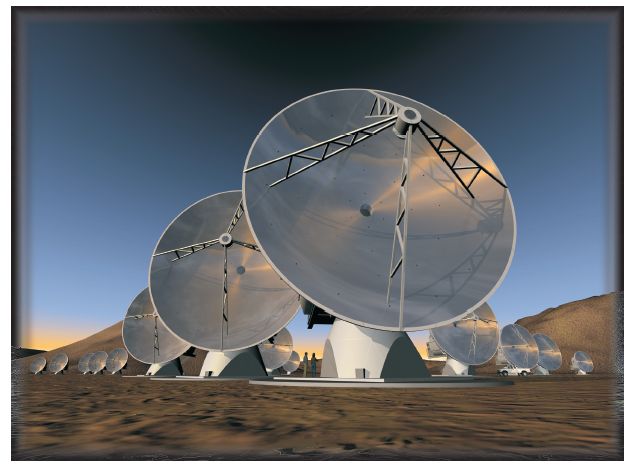
ALMA Gains Capabilities with Japan's Entry
Japan entered the ALMA Project with the signing of an Agreement Concerning the Construction of the Enhanced Atacama Large Millimeter/Submillimeter Array. The Agreement was signed by Arden L. Bement, Acting Director of NSF, Catherine Cesarsky, Director General of ESO, and Yoshiro Shimura, President of the National Institutes of Natural Science (NINS) of Japan. All parties had signed the document by September 14, 2004, making Japan an official partner in an Enhanced ALMA, to be known as the Atacama Large Millimeter/Submillimeter Array (same ALMA acronym). Final negotiations on an operations plan for Enhanced ALMA are expected to be concluded by the end of 2005. Japan will provide the Atacama Compact Array with its correlator, three receiver bands, and other components. The value assigned to the Japanese contribution to Enhanced ALMA is $180M USD (FY2000). Assuming all three partners are able to meet their commitments, the final project will be cost-shared 37.5 percent, 37.5 percent, 25 percent, between North America, Europe and Japan, respectively. The observing time, after a ten percent share for Chile, will be distributed accordingly.
The U.S. Congress has approved HR4818, the omnibus funding bill, making FY2005 the seventh year of funding for ALMA.
H. A. Wootten
ALMA Town Meeting at the American Astronomical Society
An ALMA Town Meeting will be held at the 205th American Astronomical Society (AAS) Meeting, which is being held January 9-13, 2005 in San Diego. The ALMA Town Meeting is scheduled for Tuesday, January 11, from 1:00 - 2:00 p.m., and is principally aimed at informing the North American astronomical community about the scientific capabilities and current status of the ALMA Project. The construction of ALMA has progressed rapidly; in Chile, North America, and Europe. Japan has entered into an Agreement as a new partner in ALMA; with its entry, ALMA construction activities involve Asia. The AAS ALMA Town Meeting will cover progress on all these fronts. Equally important, there will be a presentation of the North American ALMA Science Center (NAASC, http://www.cv.nrao.edu/naasc/). This center will be the main communication hub between North American astronomers and the Joint ALMA Observatory, and is being organized in Charlottesville, Virginia.
Following the presentations, there will be a discussion session where we will solicit comments from the user community, with a focus on the science user services to be provided by the NAASC. If you will be at the AAS Meeting, please plan to attend this Town Meeting. The tentative agenda for the Meeting is as follows:
| Introduction | K. Y. Lo, NRAO Director |
| ALMA Science Examples | M. Yun, U. Massachusetts |
| Project Description, Status | M. Tarenghi, Director, Joint ALMA Office |
| North American ALMA Science Center | A. Wootten, ALMA/NA Project Scientist |
| Discussion (15 mins) | A. Wootten, Moderator |
H. A. Wootten
ALMA Science Community Outreach
On October 4-8, 2004 the “Cool Universe: Observing Cosmic Dawn” conference was held in Valparaiso, Chile to introduce ALMA science to the Chilean astronomical community. The conference included several one-hour review talks on topics ranging from the CMB and cosmic reionization, to the ISM and star formation, plus numerous short contributions. The conference was well attended (about 100 participants), with the majority coming from the Chilean astronomical community, including good representation from CTIO, ESO, and the Chilean universities.
More than 230 potential ALMA and Herschel users gathered in Paris, France on October 27-29 for the “Dusty and Molecular Universe” conference, which focussed on the science the community expects to reap from ALMA and Herschel. Paul Vanden Bout spoke on the origins of ALMA, and Carlos de Breuck and John Richer presented the top-level ALMA science requirements from the newly approved Project Plan v2. A number of reviews of ALMA science capabilities were also given.
H. A. Wootten
North American ALMA Science Center
Access to ALMA science use by the North American astronomical community is through the North American ALMA Science Center (NAASC), based in the newly re-modeled NRAO headquarters in Charlottesville, Virginia. The Science Center is operated by NRAO in partnership with the National Research Council of Canada. It is one of at least two such regional support centers in the world. There will be an ALMA Town Meeting at the AAS Meeting in San Diego on Tuesday, January 11, where the structure and functionality of the NAASC will be presented to the North American astronomical community.
ALMA is designed so that very few astronomers will actually travel to Chile to obtain data. The ALMA data reduction pipeline will provide calibrated data and images to users, and an on-line archive will be maintained at the NAASC.
ALMA users can expect a wide range of support from the NAASC staff, such as: support for community participation in commissioning, science verification, and early science operations; information on ALMA observing modes and capabilities; support for the use of proposal submission and scheduling tools; validation of observers scheduling blocks; post-observation user support including detailed examination of images delivered to or produced by users; and verification of user-reported defects. The NAASC staff will also support user visits to the NAASC for data reduction, sponsor ALMA workshops and summer schools, and provide ALMA proposal guides and data reduction “cookbooks”. Information on the NAASC is available at http://www.cv.nrao.edu/naasc/. The NAASC is currently being staffed, and we welcome user feedback.
P. A. Vanden Bout
New ALMA North America Project Manager
The NRAO is pleased to announce that Dr. Adrian Russell will join the Observatory’s senior management team as the ALMA North America Project Manager in February 2005.
Adrian comes to the NRAO after nearly seven years as Director of the
United Kingdom Astronomy Technology Centre (UK ATC) in Edinburgh,
Scotland where he was responsible for the design and production of
state-of-the-art astronomical instrumentation. Adrian’s
responsibilities at the UK ATC have included: SCUBA 2, a
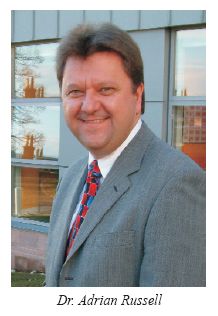 sub-millimeter bolometer array camera for the James Clerk Maxwell
Telescope (JCMT); the Mid-Infrared Instrument (MIRI), an infrared
camera and spectrometer for the future James Webb Space Telescope; and
the Visible and Infrared Survey Telescope for Astronomy (VISTA), a
wide-field 4m telescope now under development that will be sited at
the Cerro Paranal Observatory in Chile.
sub-millimeter bolometer array camera for the James Clerk Maxwell
Telescope (JCMT); the Mid-Infrared Instrument (MIRI), an infrared
camera and spectrometer for the future James Webb Space Telescope; and
the Visible and Infrared Survey Telescope for Astronomy (VISTA), a
wide-field 4m telescope now under development that will be sited at
the Cerro Paranal Observatory in Chile.
Adrian graduated from the University of Sheffield in 1983 with a 1st Class Honours degree in Electrical and Electronic Engineering and received the IEE Prize and the Mappin Medal. In 1987 he joined the Royal Observatory, Edinburgh and accepted a three-year tour of duty as a JCMT support scientist in Hawaii. Adrian received a Ph.D. in Astronomy from the University of Cambridge (Mullard Radio Astronomy Observatory), working on millimeter-wave heterodyne instrumentation and molecular-line studies of outflows in star-formation regions.
During a 1990–1992 sabbatical with Reinhard Genzel at the Max Planck Institute for Extraterrestrial Physics in Garching, Germany, Adrian worked on sub-millime-ter instrumentation for the JCMT. In 1992 he became the Head of the JCMT Instrumentation Programme at the Royal Observatory, Edinburgh.
Immediately prior to assuming his duties as the UK ATC Director, Adrian was Deputy Director of the Royal Observatory, Edinburgh and UK Project Manager for the Gemini 8m telescopes project (1995 – 2001).
The Atacama Large Millimeter Array is an essential and exciting component of the near-term future for the international astronomical community and the Observatory. Working with our ALMA partners in Europe and in Japan, Adrian Russell is an extraordinarily capable project manager whose vision and expertise will help bring the ALMA project to successful completion.
Fred K. Y. Lo
John Webber to be ALMA Front End IPT Leader
The NRAO is pleased to announce that Dr. John Webber has agreed to become the new ALMA Front End (FE) Integrated Product Team (IPT) Leader, replacing Charles Cunningham and reporting to the NA ALMA Project Manager. Charles will remain in the FE IPT as senior technical expert contributing to high-level design work. As ALMA FE IPT Leader, John will be responsible for coordinating the development and production of the ALMA Front Ends, which are a joint effort by several groups in North America and Europe. He will be directly supervising the NRAO activity in the Front End, including the Band 6 cartridges, local oscillators for all bands, and the integration and test of the completed Front End assemblies at the NRAO Technology Center in Charlottesville. This new assignment is effective October 1, 2004. John will also retain his position as ALMA Correlator IPT Leader.
Fred K. Y. Lo
Eduardo Donoso to be NA ALMA Site IPT Leader
The NRAO is also pleased to announce that Eduardo Donoso will become the new NA ALMA site IPT leader, a position formerly held by Simon Radford, who has now joined Caltech and the Cornell-Caltech 25m telescope project. Eduardo Donoso has been in charge of site construction activities in Chile since he joined ALMA in February 2004. He has prepared the bids for the construction of the NA ALMA deliverables, and for the outfitting of the Santiago ALMA Central Office and offices of the ALMA Executives.
Fred K. Y. Lo
ALMA Laboratory System Integration Tests
The first ALMA Laboratory System Integration tests have been taking place in Tucson. The setup consists of a pair of receiver simulators, receiving a coherent signal at 3mm from across the lab. A photonic system is used as the local oscillator (LO) for both receivers and is fed to the receivers along independent fibers. Fringes have been measured by mixing the IF outputs of the two receivers.
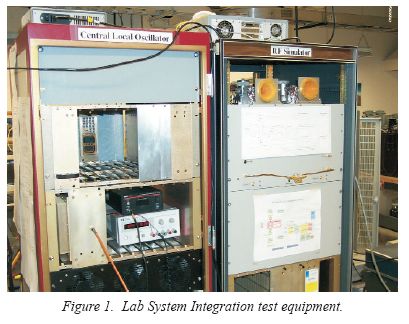
Tests to date have concentrated on checking the overall functionality of the LO system, with detailed phase noise measurements of the overall system and individual system components, including the Central Reference Generator and the Local Oscillator Reference Receiver (LORR). The performance of the first LO drivers and the overall system have been checked for phase noise at multiple frequencies within the 77-100 GHz band.
Measurements still to be made include long-term phase stability of the system and its components, and temperature dependencies. So far the measurements have included only short LO fiber transmission distances, but measurements will soon be extended to fiber lengths of several kilometers and will eventually include the fiber Line Length Corrector system. After these and other measurements, this front-end test system will be shipped to Socorro during the first quarter of 2005 for further testing in conjunction with back-end components. Later in the year the prototype system components will be moved to the Antenna Test Facility (ATF) for integrated testing as a working interferometer using the two ALMA prototype antennas.
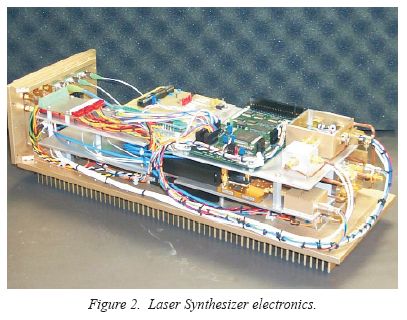
The LO is supplied by a prototype ALMA Band 6 LO source, which includes a tunable YIG oscillator, Warm Multiplier Assembly, and first LO phase-lock-loop. The LO reference is supplied by a prototype ALMA Laser Synthesizer common to both receivers. The Laser Synthesizer provides two lightwaves whose difference frequency is phase-locked to a small offset from the required LO frequency and is tunable over the full LO range. A second laser synthesizer will soon be available for locking each receiver to a separate reference, allowing further analysis of the phase noise contributions of various parts of the LO system. The central LO racks also include an ALMA prototype Master Laser, two microwave synthesizers, and photonic distribution assemblies for splitting, amplifying, and routing the fibers.
Test and integration of ALMA IF components is performed in Socorro, in cooperation with testing in Tucson. The Data Transmission System (DTS) is a major focus, including testing with the prototype correlator. A sine-wave signal was passed to the Data Transmission System (DTS) formatter and transmitter, through fiber to the DTS receiver, and processed through the prototype correlator to yield sample statistics and spectra. This first end-to-end test of the digital system was successful.
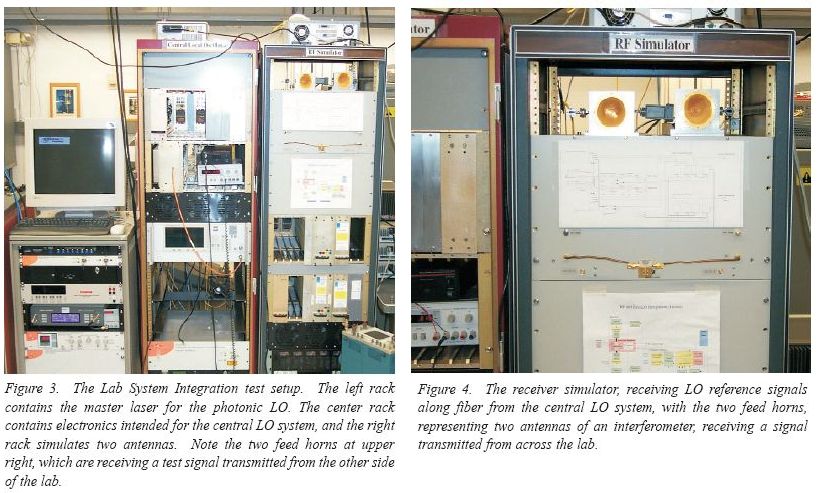
Initial testing in Tucson suggested upgrades to the Central Reference Generator/Distributor to reduce phase noise. These upgrades are under way in Socorro.
Prototype antenna tests continue at the ALMA Test Facility at the VLA site. A conceptual design for a prototype Photonics LO fiber cable azimuth and elevation wrap has been devised and discussed. A prototype will be available for testing by January.
Construction of the ALMA front-ends, covering the four bands being built in the construction phase, continues. Performance tests of the 1.3mm cartridge continue at the NRAO Technology Center. The first cryostat, into which the cartridges will be inserted, has arrived and undergone initial testing.
Correlator construction is also proceeding at the NRAO Technology Center. The ALMA Correlator consists of four quadrants. Construction of the first quadrant of these has progressed very well and progress has also been made on the second quadrant.
In Figure 1, the left rack represents the central LO system, and the right rack represents the system at the antennas. Note the two feed horns at the top of the right-hand rack, simulating reception at two different antennas; the signal is received from a Gunn diode oscillator across the lab. The central LO rack and the Receiver Simulator rack are connected by short lengths of fiber carrying the photonic LO signals.
D. Emerson, R. A. Sramek, C. C. Janes, H. A. Wootten
CHILE
ALMA, NRAO, and Astronomy in Chile
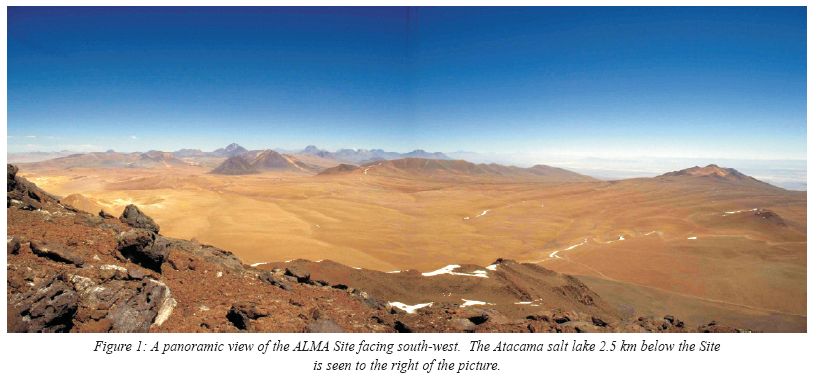
It has been ten years since an NRAO expedition located what was destined to become the ALMA site. This place, an immense plateau in the Chilean Andes situated at 5000m above sea level, is known as “Chajnantor” from the indigenous Kuntza name meaning “starting place.” And indeed the Chajnantor plateau, the best overall site for millimeter and sub-mm wave astronomy known in the world, is the place where a new era of discovery in the origins of cosmic structure, ranging from planets to galaxies, will start.
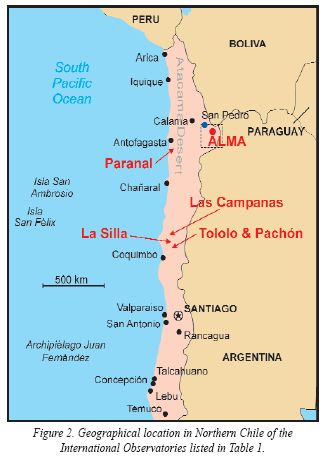 This is a breathtaking place, and not only because of the lack of oxygen but, above all, for the pristine view of the surrounding mountains and the huge Atacama salt lake lying almost two miles below (Figure 1). At this altitude, the water vapor in the atmosphere that renders most other places unsuitable to mm-wave astronomy is low enough to make Chajnantor one of the driest locations known to man. And yet, this inhospitable place is of remarkably easy access. A modern commercial jetliner takes the visitor from Santiago to nearby Calama, world capital of the copper industry (Figure 2), in less than two hours. From there, it is an hour’s drive along a modern paved highway to San Pedro, 55 km west of the ALMA site, which in turn can be reached in another hour and a half via the international paved highway connecting Chile with Argentina. All in all, it is possible to leave the capital of Chile in the morning, reach Chajnantor by noon and return to Santiago on the same day, thanks to the excellent transportation infrastructure Chile has to offer.
This is a breathtaking place, and not only because of the lack of oxygen but, above all, for the pristine view of the surrounding mountains and the huge Atacama salt lake lying almost two miles below (Figure 1). At this altitude, the water vapor in the atmosphere that renders most other places unsuitable to mm-wave astronomy is low enough to make Chajnantor one of the driest locations known to man. And yet, this inhospitable place is of remarkably easy access. A modern commercial jetliner takes the visitor from Santiago to nearby Calama, world capital of the copper industry (Figure 2), in less than two hours. From there, it is an hour’s drive along a modern paved highway to San Pedro, 55 km west of the ALMA site, which in turn can be reached in another hour and a half via the international paved highway connecting Chile with Argentina. All in all, it is possible to leave the capital of Chile in the morning, reach Chajnantor by noon and return to Santiago on the same day, thanks to the excellent transportation infrastructure Chile has to offer.
When completed in 2012, the ALMA interferometer will be the premier millimeter and sub-mm wave imaging instrument, and an unmatched example of world-wide scientific collaboration in Astronomy. Operating in this particular type of “light,” ALMA will be able to see through the dust that shrouds the regions of the Universe where new stars are being formed and will bring information on the physical properties of these regions, including images with resolution superior to those obtained in visible light from space. But why Chile? In fact, when NRAO explored the North of Chile it was only unveiling the astronomical potential of the country for this particular form of radio astronomy. Its potential for more conventional visible and infrared astronomy had been known and exploited for some 40 years, to the point that today Chile is by far the main astronomical area in the southern hemisphere and is fast reaching the status of world capital of observational astronomy. Where other countries compete for one or just a few mountains of exceptional quality, Chile offers a thousand miles of potentially exceptional sites for optical astronomy.
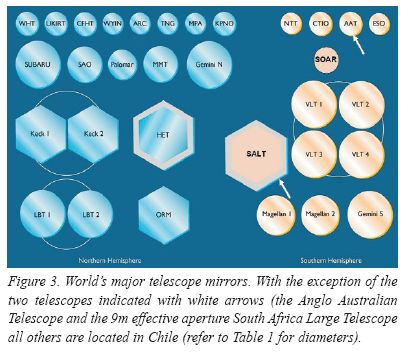
But good sites are not enough to bring the large investments and creative efforts required to build a large world-class observatory such as ALMA and those that preceded it. Chile has shown through thick and thin, and for well over a generation, its commitment to stable and generous legislation in order to attract astronomy capital. The same willingness to help that allowed AUI-NRAO to establish itself in Chile and complete with its European counterpart, ESO, the delicate negotiations required to establish ALMA had already been shown by Chile to the many international observatories in its northern mountains (Table 1). In addition Chile possesses excellent engineering and manpower and an expanding astronomical community of international quality. This local community, in exchange for access to the best observing facilities in the world, lends its strong support to new initiatives. These astronomers like to point out that in the sixties when Chile’s astronomical potential was still unknown, it was the U.S. astronomical community that took a bet on the country, thus initiating the long road that is increasingly bringing new projects to Chilean sites.
E. J. Hardy
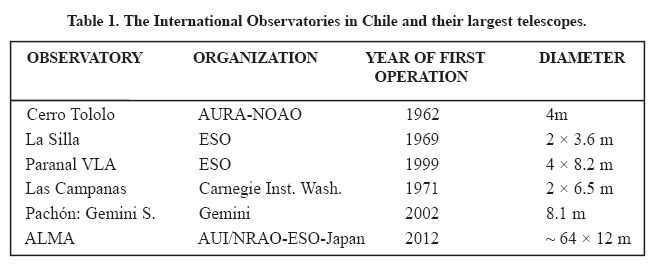
New ALMA and Executive Offices in Santiago
The last weeks of October were hectic in Santiago for ALMA and its Executives. A Board meeting was coming, the new offices were about to be finished and the happy event, always filled with surprises, of moving into new offices was about to take place.
On November 2 everything was ready for the ALMA Executive Meeting at the shiny, new ALMA offices, and the event was the right occasion to inaugurate the offices via a celebration that included the JAO and all the ALMA associates: NSF, AUI, NRAO, and ESO, as well as our new Japanese partners, who gave the celebration a special note by providing sake. Not to be outdone, the Joint ALMA Office Director, Massimo Tarenghi, uncorked an over-sized champagne bottle.
ALMA occupies the 18th floor of a modern building in Santiago’s new business area, conveniently located near subway entrances and within walking distance of restaurants and hotels. From the new offices on a clear day one can see forever, in keeping with ALMA’s mission of opening new horizons. The new offices include 800 square meters and were outfitted in three months, on time and budget, starting from an empty floor, to obtain useful office space that serves as the landing place for ALMA, including the JAO and the Executives. This was a successful joint mission, with NRAO assuming responsibility for the construction contract and its administration.
After nearly four years in breathtaking Cerro Calán in the same building as the Astronomy Department of the University of Chile, AUI-NRAO has moved to the new headquarters occupying a distinct section of the floor, next to ESO. These are the offices of the representation, business and fiscal, with additional space for visitors.
We hope that our colleagues will find on this 18th floor a new home when visiting Santiago. Comfortable accommodations, a great view, and access to high speed communications are waiting for you!
E. J. Hardy, M. Pilleux
Living at the ALMA Camp
The ALMA Camp was finished in June 2004, and the European Site IPT team, consisting of the Site IPT leader, the supervisors, and the road construction team, moved in. The first experiences in Camp living were with pre-packaged food brought from nearby San Pedro de Atacama, since the kitchen was not yet finished. The dormitories were complete other than some exterior finish work.
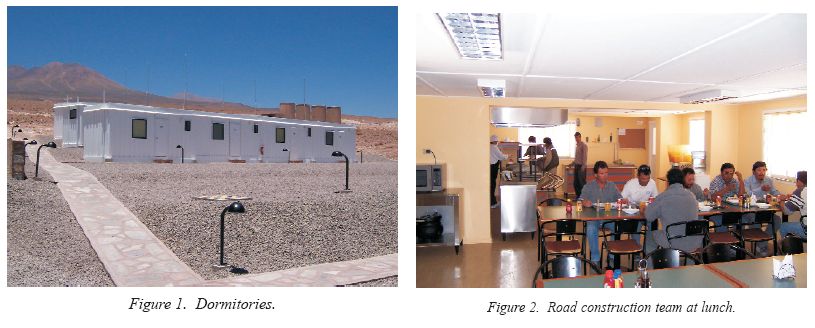
By August 2004, the Camp was complete and the kitchen was operational. Approximately 15 people have been living in the Camp since then.
Life at the Camp is quiet, beginning with a short walk to the dining room for morning breakfast, and then to work. The office is just meters from the dining room, so commuting requires only a few minutes. The construction and site supervision teams, and the road construction crew move up the hills to continue their current labor: excavation, transport, and filling. Day after day the road from the Operations Support Facility (OSF) to the Array Operations Site (AOS) improves, days that are filled with sun, dust, and thirst.
Everybody gathers at the dining room for lunch in a pleasant environment. For the road team, lunch is soup, salad, main course, and dessert. Lunch ends with a short rest under the shade of the barbecue before the day’s labor is renewed.
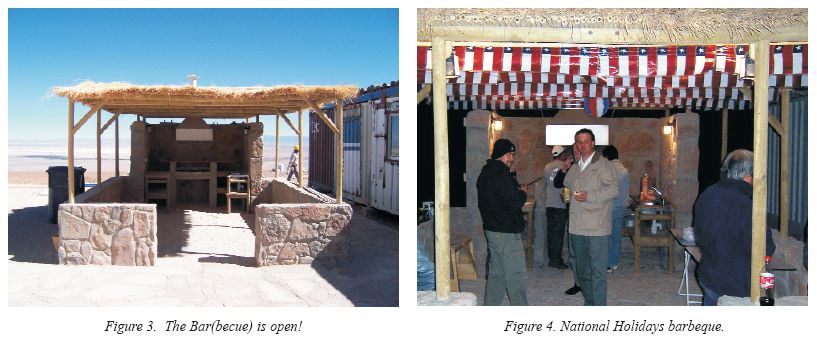
After lunch, work goes on until dusk, the most beautiful hour of the day. The desert landscape turns red with the last rays of the sun, giving the spectator a time for meditation and astonishment. After the early equatorial sunset, it is time for dinner, replenishing the energy spent during a hard day’s work. There follows relaxation, satellite TV, music, sharing conversation, watching a soccer game or the daily news, or calling home to chat with the family.
Once in a while there is occasion for celebration. For National Holidays, the barbecue becomes the center of activity. We feel lucky to be present and have the opportunity to share these moments with the people on-site. The experience cements bonds and raises everyone’s spirits.

The day ends, and it is time to rest in the desert silence to sight a shooting star, make three wishes, and bid all far away from noise and traffic jams. Nights under the good night. clearest skies invite one to enjoy star watching, perhaps to site a shooting star, make three wishes, and bid all good night.
E. Donoso




Connect with NRAO